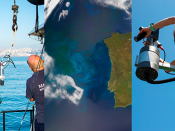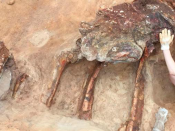Por Paulo Teixeira (Instituto Superior de Engenharia de Lisboa, Instituto Politécnico de Lisboa; e Centro de Física Teórica e Computacional, Faculdade de Ciências, Universidade de Lisboa, Portugal).
Uma gota de líquido colocada sobre um sólido assumirá diferentes formas, dependendo da permeabilidade do sólido pelo líquido, descrita quantitativamente pelo ângulo de contacto do líquido. Se colocarmos outro corpo sobre a gota, forma-se uma ponte líquida ou ponte capilar: uma parede ou coluna de líquido que liga dois corpos, que podem ser superfícies sólidas (planas ou curvas), partículas ou outros líquidos...
Abstract: The wetting of a solid by a liquid is ubiquitous in nature as well as in industry. A liquid drop placed on a solid will assume different shapes, depending on the solid's wettability by the liquid, described quantitatively by the liquid contact angle. If we place another body on top of the droplet, a liquid bridge or capillary bridge is formed: a wall or column of liquid connecting two bodies, which may be solid surfaces (flat or curved), particles,or other liquids. Liquid bridges are relevant in many contexts, such as sand art; atomic-force microscopy in high-humidity environments; soldering; the testing of weakly-adhesive solid surfaces; in lungs, where they may close small airways and impair gas exchange; the wet adhesion of insects and tree frogs; the feeding of shore birds; the spontaneous filling of porous materials; or as tools for contact angle measurements. Liquid bridges come in many different shapes, and they can cause attraction or repulsion between the bodies they connect. We started by studying a single vertical, two-dimensional liquid bridge spanning the gap between two flat, horizontal solid substrates of given wettabilities. For this simple geometry, the Young–Laplace equation can be solved (quasi-)analytically to yield the equilibrium bridge shape under gravity. We established the range of gap widths, as described by a Bond number. for which the liquid bridge can exist, for given contact angles at the top and bottom substrates. Next, we simulated the motion of this bridge when a force is applied to it parallel to the substrates, using a multicomponent pseudopotential lattice Boltzmann method. Both uniform and patterned substrates were considered, the latter consisting of alternating hydrophilic and hydrophobic stripes. We calculated the drag force exerted by the moving bridge on the confining substrates as a function of its velocity, for different contact angles and Bond numbers. We also investigated how the bridge deforms as it moves, as parametrised by the changes in the advancing and receding contact angles at the substrates relative to their equilibrium values. Finally, we determined how hard a bridge must be pushed in order to mobilise it, or to break it: bridges between uniform substrates can be mobilised by arbitrarily small forces, but in the case of striped substrates a finite force must be applied that apparently does not depend on pattern wavelength. In addition, we found that a bridge moving between patterned substrates cannot be mapped onto a bridge moving between uniform substrates endowed with some effective contact angle, even in the limit of very small pattern wavelength compared to bridge width. We shall conclude by discussing some possible future directions, including the extension to three dimensions and/or to non-Newtonian fluids.






















